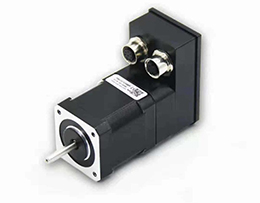- Welcome to Pulse Robot
- +86-23-63207381
- +8613677602178
- sales@pusirobot.com
Advantages and application scenarios of stepper motors
Advantages and application scenarios of stepper motors
1. What is the stepper motor?
The stepper motor is one of the motors. Although it is the same as other motors in terms of function types, it is different from other types of motors in terms of working principle and structural design.
The operation form, function performance and applicable aspects and performance of use are even different from other types of motors.
A stepping motor is a motor that converts electrical pulse signals into corresponding angular displacements or linear displacements. Each time a pulse signal is input, the rotor rotates by an angle or one step forward. The output angular displacement or linear displacement is proportional to the number of input pulses, and the speed is proportional to the pulse frequency. Therefore, stepping motors are also called pulse motors.
2. Advantages of stepping motor:
3. Application scenarios of stepper motors
1. Stepping motors are mainly used in some occasions with positioning requirements.
For example: linear cutting worktable drag, tufting machine worktable (pore positioning), packaging machine (fixed length). Basically it can be used in situations involving positioning.
2. Widely used in ATM machines, inkjet printers, plotters, photo machines, spraying equipment, medical instruments and equipment, computer peripherals and mass storage equipment, precision instruments, industrial control systems, office automation, robotics and other fields.
It is especially suitable for applications requiring stable operation, low noise, fast response, long service life, and high output torque.
3. Stepping motors are widely used in textile machinery and equipment such as computerized embroidery machines. The characteristics of this type of stepping motors are that the torque is not high, the frequent start-up response speed is fast, the running noise is low, the operation is stable, and the control performance is good. The cost of the whole machine is low.
At present, most of the stepping motors used in computerized embroidery machines are five-phase hybrid stepping motors. The purpose is to reduce the step angle and improve the control accuracy by using a high-phase stepping motor, but the performance obtained by this method The improvement is limited. And the cost is relatively high. The use of subdivision drive technology can greatly improve the running quality of the stepper motor, reduce torque fluctuations, suppress oscillations, reduce noise, and improve stepping torque resolution. If a reactive stepping motor is used, the performance can be significantly improved while the cost of the product can be greatly reduced.
4. Precautions for stepper motor application
1. The stepping motor is used in low-speed occasions-the speed does not exceed 1000 revolutions per minute (6666PPS at 0.9 degrees), preferably between 1000-3000PPS (0.9 degrees), and it can be used here by a deceleration device. At this time The motor has high working efficiency and low noise.
2. It is best not to use the full-step state for the stepping motor, and the vibration is large in the full-step state.
3. Due to historical reasons, only the nominal 12V voltage motor uses 12V, and the voltage value of other motors is not the driving voltage volt value. The driving voltage can be selected according to the driver (recommendation: 57BYG uses DC 24V-36V, 86BYG uses DC 50V, 110BYG uses a higher than DC 80V). Of course, the 12V voltage can also be driven by other driving power besides the 12V constant voltage drive, but the temperature rise must be considered.
4. For loads with large moments of inertia, a large frame size motor should be selected.
5. When the motor is under a relatively high-speed or large inertia load, it is generally not started at operating speed. Instead, it uses a gradual frequency increase to increase the speed. First, the motor does not lose step, and second, it can reduce the noise and improve the positioning accuracy of the stop.
6. For high precision, it should be solved by mechanically decelerating, increasing the speed of the motor, or using a driver with a high subdivision number. It can also be a 5-phase motor, but the price of the entire system is more expensive and there are fewer manufacturers. The argument is a layman.
7. The motor should not work in the vibration zone. If necessary, it can be solved by changing the voltage, current or adding some damping.
8. When the motor works below 600PPS (0.9 degrees), it should be driven by small current, large inductance, and low voltage.
9. The principle of selecting the motor first and then the drive should be followed.



